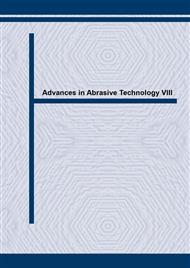p.67
p.73
p.81
p.85
p.91
p.97
p.103
p.109
p.115
Signal Analysis of Acoustic Emission for Laser Imitating Grinding Burn
Abstract:
Grinding burn is a common phenomenon of thermal damage that has been one of the main constraints in grinding in respect of high efficiency and quality. Use of acoustic emission technique for identifying grinding burn was reported before. However, the AE features of grinding burn are relatively weak and easily merged by other AE sources. This paper presents an investigation of the AE features of the thermal expansion induced by laser irradiation, which was designed to simulate grinding thermal behaviour. By means of the wavelet packet transforms, AE features at the grinding burn temperature can successfully be extracted without other mechanical interferential factors. These clean features can provide a firm foundation for analysing the real grinding burn AE features and for monitoring grinding burn.
Info:
Periodical:
Pages:
91-96
Citation:
Online since:
August 2005
Authors:
Price:
Сopyright:
© 2005 Trans Tech Publications Ltd. All Rights Reserved
Share:
Citation:


